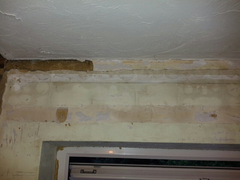James
|
| posted on 5/6/15 at 08:49 PM |

|
|
O/T plastering issue
Greetings,
We're about to have the bathroom plastered. However, it's thrown up a bit of an issue.
The current plaster is cracked all along the line of the timber 'cap' that is on top of the walls (the timber supports the joists). This
was the same in the spare room that we had skimmed and it rapidly re-cracked but it is hidden by coving.
[img]
 
Bathroom wall sm
[/img]
[img]
 
Bathroom wall2 sm
[/img]
However I don't want to put coving in the bathroom so would like other ideas please.
Should I ask the plasterer to nail plasterers 'mesh' along the timber? Would that help?
Or, the mesh could be attached to the brick only, and then plastered over and then the wood would be allowed to moved relative to the plaster and it
wouldn't crack?
Any other ideas?
Thanks!!!
James
------------------------------------------------------------------------------------------------------------
"The fight is won or lost far away from witnesses, behind the lines, in the gym and out there on the road, long before I dance under those lights."
- Muhammad Ali
|
|
|
|
|
Smoking Frog
|
| posted on 5/6/15 at 09:20 PM |

|
|
When I've had this problem I nailed plasterboard to the timber with scrim over the joint before the finishing plaster. Mesh may also work.
|
|
|
cliftyhanger
|
| posted on 6/6/15 at 06:08 AM |

|
|
As above, and there is a super wide super tough fabric mesh that can be used. But a QS told me the use of expanded metal mesh is the way to go over a
join like that. A decent plasterer should know what to do, it is hardly uncommon.
|
|
|
owelly
|
| posted on 6/6/15 at 06:59 AM |

|
|
Faced with similar problems in the past, I've used the galvanised expanded mesh (or flatten a piece of angle-bead) nailed to the timber, or
knock loads of nails into the timber and use bonding plaster.
http://www.ppcmag.co.uk
|
|
|













